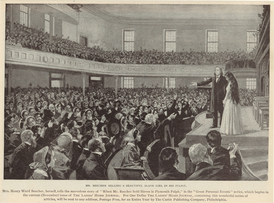Abolitionist Place
In September of 2007, Duffield Street in downtown Brooklyn got a new name. Today, the street sign reads “Abolitionist Place,” in honor of the many people in this neighborhood who braved fines, imprisonment and death threats to continue the struggle against slavery. This activity took many forms: some spoke out from the pulpit, while others hid men, women, and children in their homes as kidnappers and slave catchers roamed the streets and docks. In the 1800s the harbor nearby was one of the busiest in the world. Hundreds of ships loaded with cotton or tobacco from the South came and went. The ships also carried stowaways bent on stealing their own freedom. Other runaways were brought here by conductors of the Underground Railroad, such as the famed Harriet Tubman. They all found shelter in the neighborhood’s churches and safe houses. In addition, they were given food and clothing collected by local women’s organizations.
It is known that Thomas and Harriet Truesdell, both staunch abolitionists, lived at 227 Duffield. Some say the homes up and down the block were part of the Underground Railroad. Runaways were hidden in the Bridge Street AWME Church, the first African American church in Brooklyn, just two short blocks away. A 10-minute walk from Abolitionist Place was the Plymouth Church of the Pilgrims, known as the “Grand Central Depot” of the Underground Railroad. Abraham Lincoln came to the church, as did Frederick Douglass and Sojourner Truth. The name Abolitionist Place honors all the men and women, both black and white, that made this neighborhood a hotbed of antislavery activity.
This entry contributed by
Curriculum Concepts International
Related Media
Images

|
In the fall of 2007, a new street sign went up. “Abolitionist Place,” at Willoughby and Duffield Streets, honors the brave antislavery efforts of this neighborhood in the 1800s.
|

|
The neighborhood around Duffield Street was a hotbed of antislavery activity. At the Plymouth Church of the Pilgrims, mock slave auctions raised money and a “panic of sympathy.”
|
